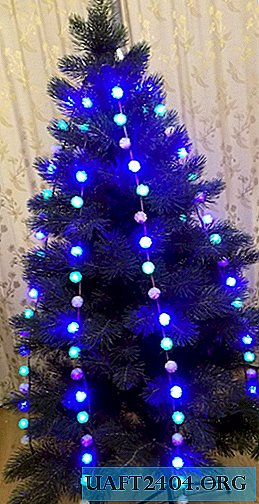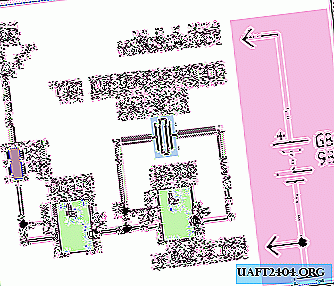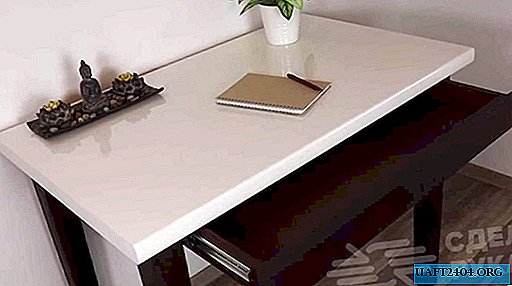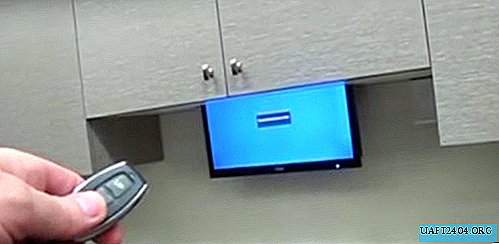Share
Pin
Tweet
Send
Share
Send
The smart decision is to create a garland with your own hands.
- Firstly, it will be a 100% original product.
- Secondly, the configuration of the jewelry will be exactly as you need it.
- Thirdly, it is a real money saving.
- And finally, you can safely say to family members, and especially children: "Dad can!"
The greatest difficulty is the lighting of the Christmas tree. Actually, there are only two options: wrap a standard garland in a spiral, or try to arrange it vertically, in the form of a pyramid. We choose the second option, especially since the lines can be made of the required size: the height of the Christmas tree.
The concept is as follows: wires are pulled from the top to the lower branches, the LEDs are arranged at the same interval, as if creating tiers.

The light must be dynamic: a control controller is required. Simple LEDs shine beautifully, but spotlights do not create volume. So you need shades for each LED element.
Garland calculation starts from the power supply. The option is purely individual: I used an unnecessary power supply from a laptop. The estimated number of LEDs is no more than 100 pieces, using standard 5 mm LEDs, the total current consumption (20 mA * 100) is 2 A at maximum brightness. For the serial connection of 6 diodes (voltage drop at each of the order of 3 volts), the voltage of the power supply is 18-20 volts.
General calculation of the power of the garland:
We collect 5 lines. Each "thread" consists of 18 LEDs of 6 pcs. per channel (RGB option). 18 * 5 = 90 pcs., Total current 1.8 A. Thus, the power supply for a laptop with parameters: 19 volts, 4 amperes, is suitable. At the same time, a double power reserve is provided.
Selection of necessary materials:
1. LEDs. I ordered on Aliexpress: 3 packs of 100 pieces red, green and blue LED straw hat elements, dispersion angle 120 degrees.
2. Controller with Aliexpress. Let us dwell on this element in more detail. If you don’t feel like wasting time making your own circuit (there are many options, the cheapest of them is on Arduino), you can take a ready-made controller for RGB tape. All schemes work on the same principle: 3 controlled channels, the order of inclusion, and the brightness of the light are set. Actually, the three colors are conditional here, you can connect 3 channels of the same LEDs, and enjoy the lighting effects.
To power the 19-volt channels, I chose a controller with a universal voltage of 12-24 volts. The control circuit is powered by any voltage in this range, at the output we get the voltage of the power supply: in my case, 19 V.
A prerequisite (for my scheme) is the presence of a remote control mode.
3. Instead of wiring harness, I chose RGB loop (3 channels + 1 common).
4. Heat shrink tubes of different colors.

For ease of installation, I used 4 pin dupon connectors (pitch 2.54 mm). The corresponding set has long been purchased from the same Chinese, a great help for various electronic crafts.

Since I planned to hide the LEDs in the shades - a package of 100 pcs was bought on Aliexpress. snowflakes for garlands. Landing diameter 5 mm.

Calculation of the connection scheme
LEDs, even with a serial connection (in my case, 6 diodes), are connected through a quenching resistor. Parameters of LED elements on the package:

The calculation of the resistor is carried out according to the formula, or on an LED calculator. I used the online service: //cxem.net/calc/ledcalc.php
- For the RED channel (voltage drop 1.8-2.0 V), the resistance is 420 Ohms.
- For channels GREEN and BLUE (voltage drop 3.0-3.2 V), the resistance is 82 Ohms (green) and 75 Ohms (blue). The green LED element shines brighter, therefore a resistor with a higher rating, to equalize the overall picture.
The block diagram (together with the principal) in the illustration:

I bought a controller for RGB LEDs with a common anode. That is, minus is applied to each channel, and plus to the common wire.
Garland
You can use twisted wires, as in factory garlands. I liked the design on the loop more.

We make a reinforced leg for each LED element. To do this, you need toothpicks and heat shrink.

We collect, heat the hair dryer.

It turns out this design:

It makes sense to immediately prepare and check all 90 LEDs.

Then we mark the loop, determining the installation location of the diodes through an equal distance. I made neat cuts along the loop on the wires of the desired color, cut and tinned the installation site.

After assembly, each LED looks like this:

It turned out neatly and reliably.
It is convenient to solder on the device with a magnifying glass, which is called the "third hand".

Next, we connect the supply wire (common "+") to the channels, through the resistors.

Insulate the parts with heat shrink.

And connect with the "plus".

We cover this loop with a large diameter shrink.
We install connectors on the opposite end.

The result was 5 identical three-channel lines of 18 LEDs.

We assemble the connection node: 5 mating connectors with a common control loop.

The result was such a cable: on the one hand - 5 connectors for lines with LEDs, on the other hand - a connector for connecting to the controller. When attaching the assembly to the tree, I used a long clamp.

We connect the lines, check all the controller modes.

Then we put snowflakes on the LEDs.

The lesson is not easy (after all, 90 pieces!), But fascinating.

Check again. The effect is amazing.

Note: Working LEDs do not work well in photographs, so the image is significantly worse than the original.
It remains to mount the garland on the Christmas tree - and call the child: admire my father's work.

Total:
The total financial cost of the garland is not more than 1000 rubles. The main consumable part is a ready-made controller. The power supply is shareware. Diodes and wires are mere pennies. Additional costs: 300 rubles for ceiling snowflakes. The option is optional, but significantly increases the attractiveness of the garland.
The time spent (4 full days off) is not at all a pity: it was interesting to work, and the result is worth it.
Share
Pin
Tweet
Send
Share
Send











